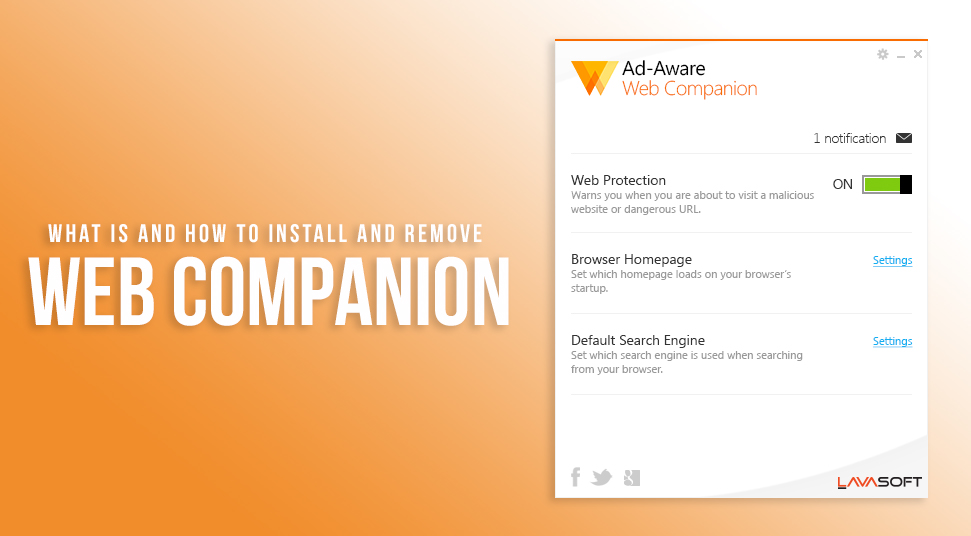Why do I have Adware Web Companion Installed on my System?

The Internet is a vast online resource for a wide range of information, data, and files. You can upload or download files, programs and even games as well. However, there’s the risk of inadvertently downloading a virus or malware. These malicious programs can harm your system or breach your privacy by accessing your personal files and folders. Regarding malware and adware, Web Companion is one such example that will be discussed here.
What is Web Companion?
Web Companion is advertised as security software that protects the user from malware and virus. It is developed by Lavasoft which is now known as Adaware. Usually, it is installed in the system through bundling. This is an installation method where one software is installed along with another software. Sometimes, it is installed without the user’s knowledge. Alternatively, you can get this software for free from its official website.
How is Web Companion Used?
As stated earlier, Web Companion was meant to be used as security software. It claims to block ads and protect the system from malware and viruses. Moreover, it offers the best secure search while also blocking suspicious websites and URLs. However, it functions as an extension latched onto a web browser.
Is Web Companion a Virus?
As of now, Web Companion is listed as a PUA which stands for Potentially Unwanted Application. This is because it is installed in the system without the user’s knowledge. Hence, the program is installed through deceitful means such as pop-ups, bundling, and other methods.
Another problem is that Web Companion changes the default browser settings in the system. As a result, it can create various problems for regular users. It changes the default search engine to Bing and installs an extension as well. Moreover, it can inject ads of its own and even redirect to other websites. Therefore, it can potentially slow down your browser.
During installation, it will schedule its own actions with the Windows Scheduler. Thereafter, it will randomly scan the system and tell you that there’s a virus. Next, it will ask for a payment of a small fee to remove these viruses from the system. According to some users, it tracks browsing activity and shares the information with third parties.
How to Remove Web Companion?
To begin with, it is very easy to remove Web Companion from your system. Thus, go through the following steps in the order they’re given.
Step 1 – Stop Web Companion Process
First, you need to forcefully end the system process for Web Companion. This can be done by following the given instructions.
- Press CTRL + Shift + Esc button from your keyboard at the same time. This will launch the Task Manager.
- Next, head over to the Processes tab and find the Web Companion process from the list. It could be named as Lavasoft or Adaware as well.
- Right-click on the process and choose the ‘End process’ from the list. Thereafter, close the window.
Step 2 – Uninstall Web Companion
Next, you need to remove Web Companion through the control panel. Hence, follow the steps provided in the given section.
- Press the Windows logo button along with the letter ‘R’ at the same time. Next, type ‘appwiz.cpl’ in the text field and press enter.
- Now, you will see a list of all the installed programs on your computer. Find and select the Web Companion from the list.
- Right-click on the program and choose Uninstall. Follow the instructions as displayed on the screen for Web Companion Removal. Restart your computer for good measure.
Step 3 – Delete Leftover Files
Subsequently, you have to make sure whether there are any leftover files in the system or not. To do this, follow the given steps.
- Press the Windows logo button along with the letter ‘E’ at the same time. Next, head over to the directory where Windows is installed.
- There, navigate to Program Files and delete any folder called ‘Lavasoft’, ‘Adaware’ or ‘Web Companion’.
- Go back and do the same for the Program Files (x86) folder as well. Make sure that there are no folders related to Web Companion in this directory. After that, close the open window.
Step 4 – Delete Registry Entries
Now, you need to make sure that there is no registry values leftover in the system. Hence, go through the given instructions to remove it.
- Press the Windows logo button along with the letter ‘R’ simultaneously. There, type ‘regedit’ and press Enter.
- Click on Yes if prompted. Now, the Registry Editor will appear on your screen. Press CTRL along with the letter ‘F’ at the same time.
- Here, type ‘WebCompanion’ and delete any entries that you find. Similarly, do the same for ‘Lavasoft’ and ‘Adaware’. Later, close the registry editor.
Step 5 – Reconfigure Browser Settings
Lastly, you need to change back your browser settings as it was modified by the Web Companion. Here, you have two optional methods to do so. Hence, go through the following options according to your preference. We have provided detailed steps for Google Chrome and Firefox as they’re the most used browsers.
Remove Malicious Extensions
Google Chrome
- Click on the three dots located on the top right of the Chrome window. Thereafter, click on More Tools.
- Here, click on Extensions from the list of options. This will display all the installed extensions in Google Chrome.
- Find and Remove all the malicious extensions from this window. Thereafter, open a new tab and check if you’re still facing issues.
Mozilla Firefox
- Click on the three bars located on the top right of the Firefox window. Next, head over to Add-ons.
- Here, click on Extensions and you will see all the extensions installed in your browser.
- Find and delete all the unwanted extensions from your browser. Next, open a new tab and check if the browser is still running slow.
Reset Browser Settings
Google Chrome
- Open the Chrome menu by clicking on the three dots. Next, click on Settings and scroll down to Advanced Settings.
- Here, you should see an option for Reset Browser Settings. Click on it.
- A new pop-up will appear asking for confirmation. Click on Reset once again and the browser will be reset. This will remove all site settings, cookies, and extensions from Google chrome.
Mozilla Firefox
- Open the Firefox menu by clicking on the three bars. Next, go to Help and click on Troubleshooting Information.
- Here, you will see an option called Refresh Firefox. Simply click on it.
- Next, you will see a pop-up window asking for confirmation. Click on Refresh once again and your browser will be reset. Accordingly, all your site data, extensions and other settings will revert back to default settings.
Final Note
In conclusion, Web Companion is a potentially unwanted application that can cause your browser to perform poorly. Hence, it is advised to remove the Web Companion by following the above instructions. Follow all the steps accordingly to effectively remove the program from your system.

 Stars-923: Unveiling the Mystical Cosmos
Stars-923: Unveiling the Mystical Cosmos  Buying Guide for Short-Throw 4K Projectors for Gaming
Buying Guide for Short-Throw 4K Projectors for Gaming  5 Best Wireless Apple CarPlay Adapters in 2024
5 Best Wireless Apple CarPlay Adapters in 2024  The Essential Role of Animated Explainer Videos in Tech Documentation
The Essential Role of Animated Explainer Videos in Tech Documentation  How Do You Apply Agile Testing Principles And Practices Across Different Domains And Contexts?
How Do You Apply Agile Testing Principles And Practices Across Different Domains And Contexts?  What Are The Benefits And Challenges Of Using Mock Objects In TDD?
What Are The Benefits And Challenges Of Using Mock Objects In TDD?